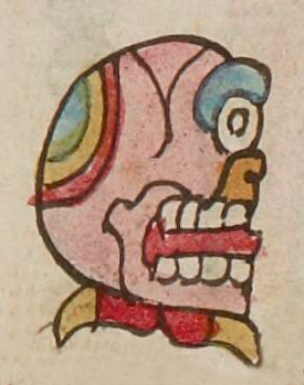miquiztli (TR8r)
This colorful simplex gloss of the calendrical day sign, Miquiztli (Death), has been carved from a date. It shows a human skull in profile, looking toward the viewer's right. The skull is predominantly pink with a turquoise blue brow, an orange nose cavity, white teeth, a red slightly protruding tongue, and, on the back of the skull, concentric circles radiating out from a turquoise blue center, then a yellow ring, and then a red ring. Below the lower jaw are what appear to be internal organs in red and yellow.
Stephanie Wood
Organs, as shown below, typically come in red and yellow. Scalloped yellow edges can suggest a severing, such as can be seen in the severed part of the tree of Tamoanchan (also below). The autonomous-era sculpture of the divine force of Coyolxauhqui, who was cut into many pieces, has these scalloped edges all over it. For more on red and yellow interiors, see the article on the left navigation bar.
Stephanie Wood
ca. 1550–1563
deaths, muerte, muertos
Ce Miquiztli. An date on the Teocalli de la Guerra Sagrada, Museo Nacional de Antropología e Historia, Salón Mexica. Photograph by Stephanie Wood, 14 February 2023.

miquizt(li), death; mortality; also, a calendrical marker, https://nahuatl.wired-humanities.org/content/miquiztli
Telleriano-Remensis Codex, folio 8 recto, MS Mexicain 385, Gallica digital collection, https://gallica.bnf.fr/ark:/12148/btv1b8458267s/f41.item.zoom
The non-commercial reuse of images from the Bibliothèque nationale de France is free as long as the user is in compliance with the legislation in force and provides the citation: “Source gallica.bnf.fr / Bibliothèque nationale de France” or “Source gallica.bnf.fr / BnF.”











